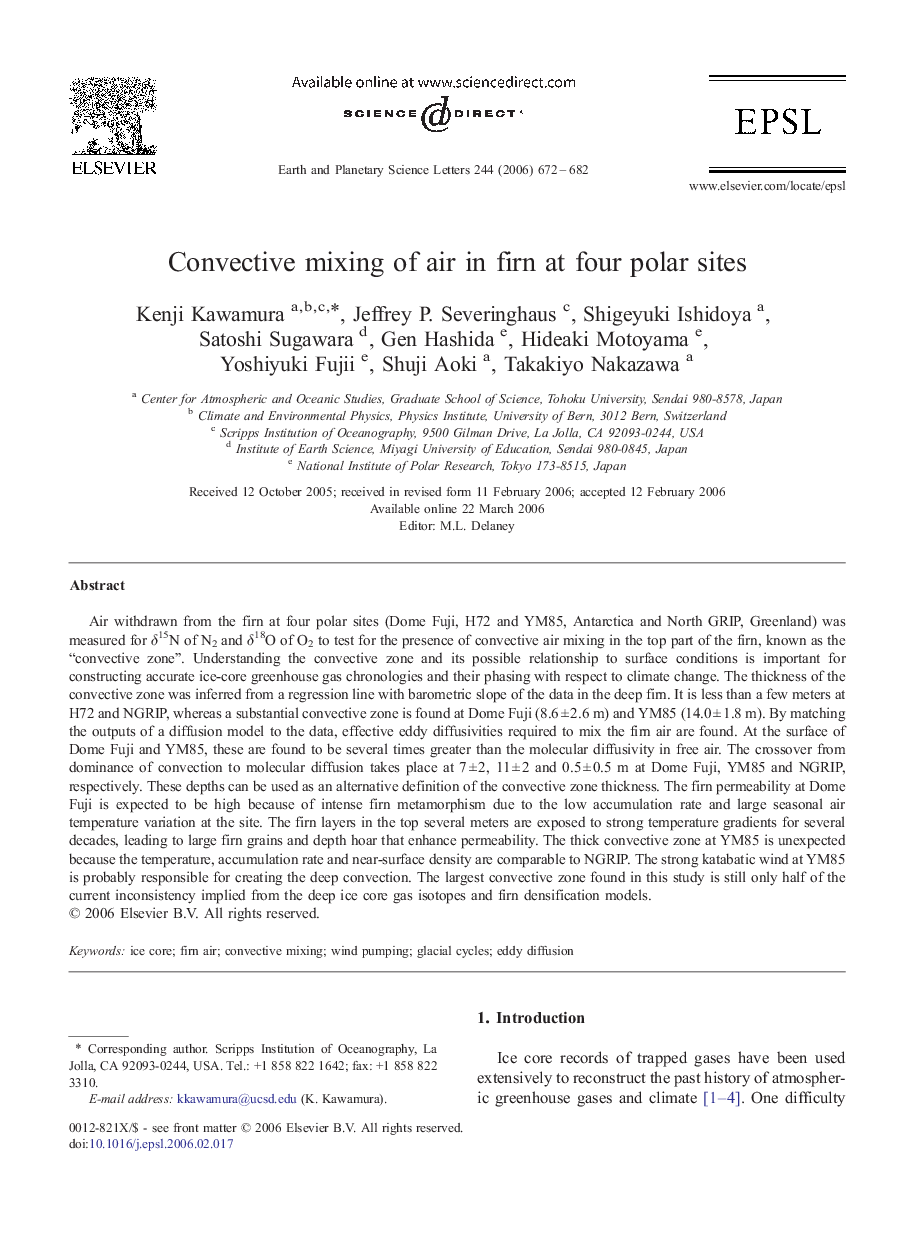| کد مقاله | کد نشریه | سال انتشار | مقاله انگلیسی | نسخه تمام متن |
|---|---|---|---|---|
| 4681040 | 1634946 | 2006 | 11 صفحه PDF | دانلود رایگان |
عنوان انگلیسی مقاله ISI
Convective mixing of air in firn at four polar sites
دانلود مقاله + سفارش ترجمه
دانلود مقاله ISI انگلیسی
رایگان برای ایرانیان
کلمات کلیدی
موضوعات مرتبط
مهندسی و علوم پایه
علوم زمین و سیارات
علوم زمین و سیاره ای (عمومی)
پیش نمایش صفحه اول مقاله

چکیده انگلیسی
Air withdrawn from the firn at four polar sites (Dome Fuji, H72 and YM85, Antarctica and North GRIP, Greenland) was measured for δ15N of N2 and δ18O of O2 to test for the presence of convective air mixing in the top part of the firn, known as the “convective zone”. Understanding the convective zone and its possible relationship to surface conditions is important for constructing accurate ice-core greenhouse gas chronologies and their phasing with respect to climate change. The thickness of the convective zone was inferred from a regression line with barometric slope of the data in the deep firn. It is less than a few meters at H72 and NGRIP, whereas a substantial convective zone is found at Dome Fuji (8.6 ± 2.6 m) and YM85 (14.0 ± 1.8 m). By matching the outputs of a diffusion model to the data, effective eddy diffusivities required to mix the firn air are found. At the surface of Dome Fuji and YM85, these are found to be several times greater than the molecular diffusivity in free air. The crossover from dominance of convection to molecular diffusion takes place at 7 ± 2, 11 ± 2 and 0.5 ± 0.5 m at Dome Fuji, YM85 and NGRIP, respectively. These depths can be used as an alternative definition of the convective zone thickness. The firn permeability at Dome Fuji is expected to be high because of intense firn metamorphism due to the low accumulation rate and large seasonal air temperature variation at the site. The firn layers in the top several meters are exposed to strong temperature gradients for several decades, leading to large firn grains and depth hoar that enhance permeability. The thick convective zone at YM85 is unexpected because the temperature, accumulation rate and near-surface density are comparable to NGRIP. The strong katabatic wind at YM85 is probably responsible for creating the deep convection. The largest convective zone found in this study is still only half of the current inconsistency implied from the deep ice core gas isotopes and firn densification models.
ناشر
Database: Elsevier - ScienceDirect (ساینس دایرکت)
Journal: Earth and Planetary Science Letters - Volume 244, Issues 3â4, 30 April 2006, Pages 672-682
Journal: Earth and Planetary Science Letters - Volume 244, Issues 3â4, 30 April 2006, Pages 672-682
نویسندگان
Kenji Kawamura, Jeffrey P. Severinghaus, Shigeyuki Ishidoya, Satoshi Sugawara, Gen Hashida, Hideaki Motoyama, Yoshiyuki Fujii, Shuji Aoki, Takakiyo Nakazawa,